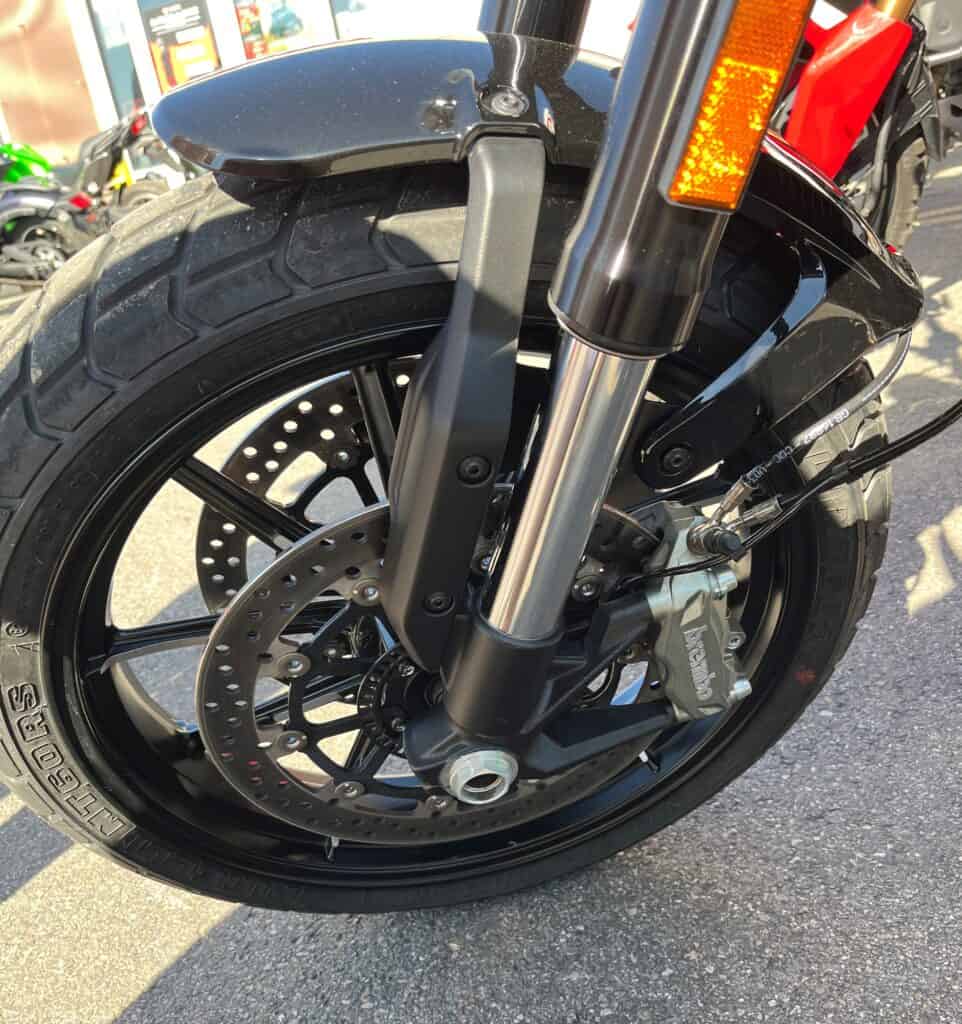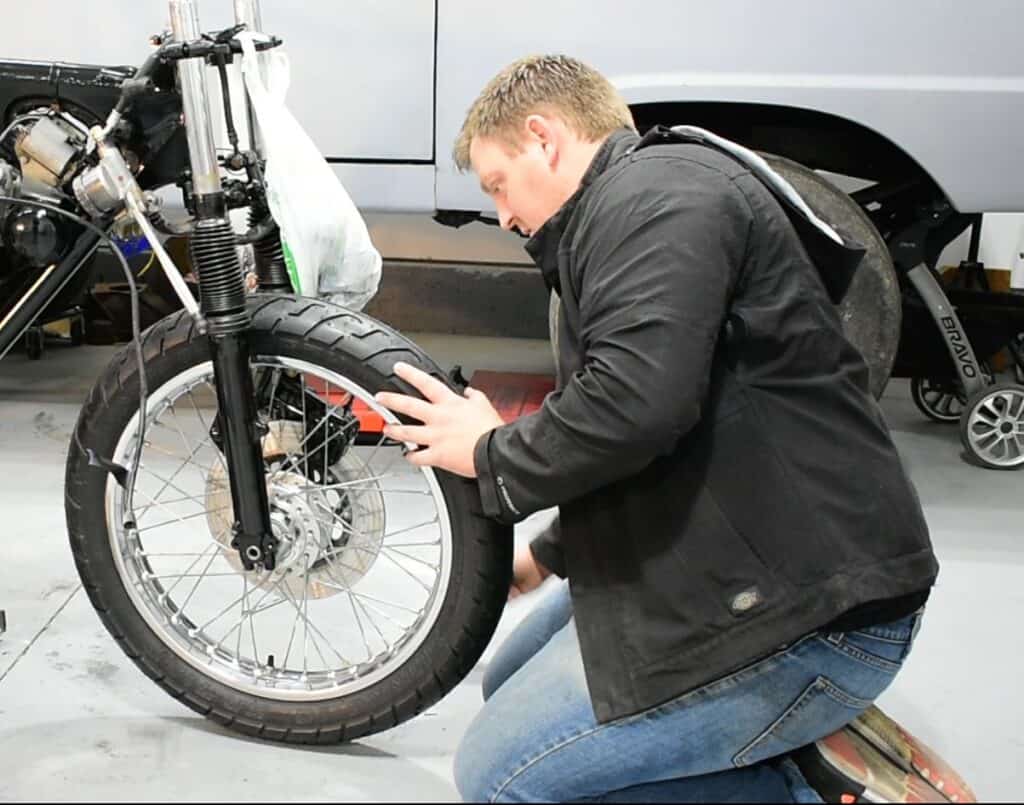
Routine maintenance on a motorcycle is essential not only for prolonging the life of the motorcycle, but also for your safety as a rider. In this case, perhaps you were replacing the brake pads and noticed the rotor was a bit warped. At this point, you may be wondering if your motorcycle rotors can be “turned” or smoothed down.
Can motorcycle rotors be turned? Yes, motorcycle rotors can be turned. Before turning your rotors, refer to your owners manual about their minimum thickness and ensure any grooves aren’t below that. Some rotors are coated with certain materials to enhance performance; these types of rotors should be replaced and not turned. Turning motorcycle rotors should be performed by a professional.
By turning the rotors, you are able to shave them down some to level everything out. This can bring any high or low points on the rotors together and help carve out any grooves provided that they aren’t too deep. This will allow your brake pads to be applied more evenly for better stopping power and smoother braking. Let’s dive a little deeper into what turning rotors on a motorcycle can look like.
Why Motorcycle Rotors Can Be Turned
Your rotors serve a critical feature on your motorcycle. As you are pressing the brakes, the brake pads press down against the rotor. This friction between the pads and the rotor is what slows your motorcycle down and can allow you to stop. Everyone is aware that your brake pads need to be replaced from time to time when they get too worn down. Unfortunately, not nearly as much attention is put onto your rotors.
As your rotors are the other part of this stopping process, they also do wear over time. They get worn down just like brake pads (although they generally last longer than the pads). They also can begin to wear unevenly leading to vibrations or pulsating while braking. Lastly, grooves can also get carved into the rotors over time.
In most cases, motorcycle rotors aren’t any different than rotors on your car; they are a single component solid rotor. There are some special floating brake rotors out there that are made of two main components that are connected with pins or bobbins. Turning these types of rotors should be done with extreme caution and only by someone who knows what they are doing as this can affect how the two components float and therefore affect your braking performance.
In most cases though, your motorcycle will have just a single solid rotor. These can be turned as long as there isn’t too much damage on them. The first thing to check to ensure that you can turn your rotors is to check the minimum thickness of your specific rotor. Each manufacturer has a specific minimum thickness for their rotor. This is the thinnest that the rotors can be and still safely and reliably be used. To check your current thickness as compared to the minimum thickness, you can use a set of calipers to measure the thickness to ensure you are proceeding safely.
Secondly, you will want to check your rotors for excessive wear. If the rotor is extremely damaged, it’s generally better to just replace it entirely instead of trying to turn it back into a good rotor. The things to look for are generally warping or deep grooves. The deep grooves you can see with your eyes, but detecting warping can be a little bit trickier. While using your calipers, you will want to rotate the rotor while checking for the amount of runout. If this falls out of acceptable limits, then the rotor may be warped badly enough that it needs to be replaced.
The last thing to be aware of is if there are any special types of coating on your rotors. Some rotors come with special coatings that improve certain characteristics of the rotor. This could be to help your motorcycle stop quicker, or that it handles heat better, etc. Turning your rotors can actually remove these special coatings and therefore change the performance of your brakes. If you have such a special rotor, you may want to look into just replacing it instead of turning it.
How To Tell If The Rotors Need To Be Turned

At this point you might be wondering how you will know when your rotors need to be turned. There are a couple of different things that you can do to help you know if you should turn them. First off, the simplest thing to do anytime is to visually inspect the rotors.
Take a look at the surface of the rotor. Do you notice any sort of grooves being formed, uneven wear, or scoring? If you do, then that means you probably will want to have these turned to ensure braking is applied evenly and smoothly. You can also look for rust or corrosion. Turning the rotors can remove this from the surface of the rotors. If there is too much rust though, they may not be able to be turned.
Secondly, there are several different noises or sensations you might experience that indicate that your rotors need to be turned. First, when you hit the brakes (both handlebar or foot brake) and you notice vibrations or pulsations, then that is generally a sign that your rotors have worn unevenly. These vibrations or pulsations you are feeling are the brake pads being applied to the brakes across high and low spots on the rotors thus resulting in vibrations. The more uneven the rotors are the more intense these pulsations could be.
You also might notice grinding or squealing sounds coming from your brakes. While these sounds most often come from the brake pads when they start to get worn down, they can sometimes come from the rotors themselves if they are damaged. If you do hear this sound, you will want to take a look at your brake pads first. If they still have plenty of pad material, then you should take a look at your rotors and ensure that they aren’t damaged.
I have restored dozens of motorcycles and have dealt with many rotor issues. Luckily, it’s pretty easy to tell when these are warped; I was even able to tell they needed attention early in my motorcycle restoration days. You’ll be able to tell easily through these previous suggestions even if you’re not mechanically minded.
How To Safely Turn/Face Motorcycle Rotors
So, how can rotors be turned? In most cases, this isn’t something that your average person will do. To turn the rotors requires a special lathe that most DIY mechanics aren’t going to have. If you happen to have the necessary equipment, then you are welcome to follow along with this tutorial. Just be sure that if you do try this, be extremely careful to not overturn them and to check for runout afterwards as this can make riding your motorcycle dangerous. I highly recommend that this is done by a professional.
If you consider yourself to be a professional, the very first thing that you will want to do is check the specs on your motorcycle. Your owner’s manual should specify the minimum thickness of your rotors. Once you check that, you can go measure the thickness of your rotors with some calipers to make sure that they can be safely turned.
You will now need to remove the rotors from your motorcycle so that they can be turned. Once removed, you will need to mount the rotors to your lathe. Make sure that they are properly centered and balanced. Once mounted, you are able to fire up the lathe and remove a very thin layer of material from the surface of the rotor. You will want to be sure that your rotor remains smooth and flat during and after this process.
Once you have finished turning the rotor, you will want to check it for runout and thickness. Checking the thickness is easiest. This way you can guarantee that you didn’t remove too much material from the rotors such that it would jeopardize the integrity of the rotor. You will also want to check for runout. Once you are happy with these two things, you can reinstall the rotors to your motorcycle. You will likely need to do a break-in procedure for your brakes to ensure that the pads and rotor come into contact together properly and that your stopping power is where you expect it to be.
How Much Can You Safely Shave Off A Rotor?
So, how much can you safely shave off of your rotors? This will vary quite a bit across different motorcycles and also across different rotors. You should always look up and know the minimum thickness of your rotors if you are planning to turn them. Going any thinner than this can result in failure of your rotors which means you could lose your braking ability unexpectedly.
If you check your minimum thickness, you now know the thinnest that they can possibly be and still function properly and safely. Now you will need to check the current thickness of the rotors. If you subtract the minimum thickness from the current thickness you will then know the absolute maximum amount that you can shave off, although you probably don’t want to take it right to the minimum.
